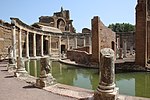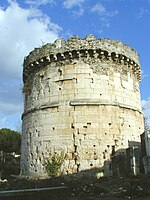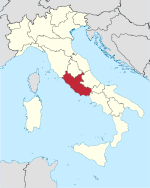Santuario di Nostra Signora di Fatima a San Vittorino
20th-century Roman Catholic church buildings in ItalyCentralized-plan churches in ItalyItaly Roman Catholic church stubsRoman Catholic churches completed in 1979Roman Catholic churches in Rome
The Santuario di Nostra Signora di Fatima is a church in Rome, in the zone San Vittorino. Although located in the commune of Rome, from the ecclesiastical point of view it is part of the Diocese of Tivoli. It was built between 1970 and 1979 to the designs of the architect Lorenzo Monardo and inaugurated May 13, 1979 by Monsignor Guglielmo Giaquinta, Bishop of Tivoli. The ground plan is a circle and the vault is in the shape of an inverted funnel. The glass doors of the portal, representing the Passion of Christ, are the work of the Franciscan priest Ugolino from Belluno.
Excerpt from the Wikipedia article Santuario di Nostra Signora di Fatima a San Vittorino (License: CC BY-SA 3.0, Authors).Santuario di Nostra Signora di Fatima a San Vittorino
Via Muracce della Piana, Rome Municipio Roma VI
Geographical coordinates (GPS) Address External links Nearby Places Show on map
Geographical coordinates (GPS)
| Latitude | Longitude |
|---|---|
| N 41.9158 ° | E 12.7915 ° |
Address
Santuario Nostra Signora di Fatima
Via Muracce della Piana
00019 Rome, Municipio Roma VI
Lazio, Italy
Open on Google Maps










